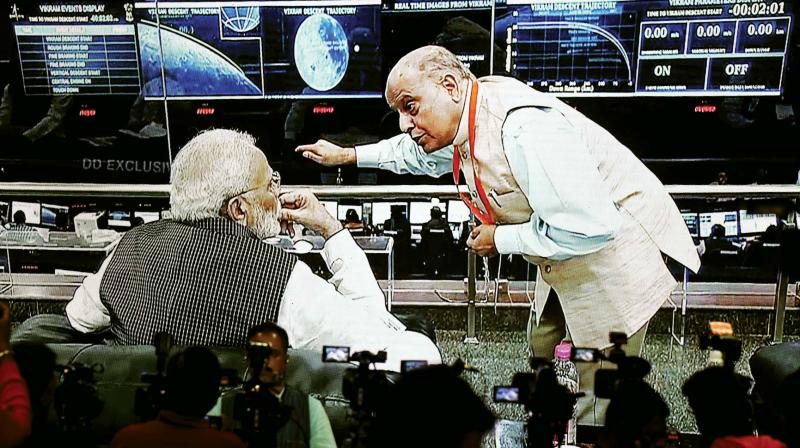Isro on 14-day hunt for Vikram lander
India’s bold moon touchdown mission faces setback, contact with lander lost just 2.1 km away.

Bengaluru: Indian space scientists came heartbreakingly close to scripting history and landing a probe on the Moon but lost the communication link with lander ‘Vikram’, marking an unexpected end to their plans to secure pride of place in lunar sciences as well as meet the high expectations of more than a billion Indians, on Saturday.
It was an excruciating moment for the space scientists as the lander, which was gliding on its own towards the lunar surface, encountered a snag when it was a mere 2.1 km from the landing site. They were looking forward to their place in the sun by attempting to land a probe close to the South Pole but as the designated hour of landing, 1.55 am, drew closer, they grew anxious and scanned their consoles for some semblance of signals from ‘Vikram’.
A few minutes past 2.00 am, a distraught Dr K Sivan, chairman of Isro, made his way to the VIP viewing gallery at ISTRAC’s Mission Operations Complex, to give Prime Minister Narendra Modi the bad news.
Dr Sivan broke down while seeing off Mr Modi but was comforted by the Prime Minister, “There are ups and downs in life. This is not a small achievement. The nation is proud of you. You all have done a big service to the nation, science and mankind. I am with you all the way, move forward bravely.”
Mr Sivan later said that scientists will continue to contact Vikram, which had life of a lunar day which translates into 14 earth days, suggesting efforts to re-establish communication with Chandryaan 2’s lander.
“We will be trying to establish a link, we will try for the next 14 days,” said Mr Sivan when asked if there was any chance of reconnecting with the lander. Mr Modi also tweeted immediately after heading out of ISTRAC, “These are moments to be courageous, and courageous we will be.”
A few minutes past 2 am, a distraught Dr K. Sivan, Chairman, ISRO, made his way to the VIP viewing gallery at ISTRAC's Mission Operations Complex (MOX), to give Prime Minister Narendra Modi the bad news. Dr Sivan broke down while seeing off Mr Modi but was comforted by the Prime Minister: "There are ups and downs in life. This is not a small achievement. The nation is proud of you. You all have done a big service to the nation, science and mankind. I am with you all the way, move forward bravely."
Mr Modi also tweeted immediately after heading out of ISTRAC: "These are moments to be courageous, and courageous we will be."
As originally planned, the lander commenced the descent at 1.38 am from its orbit 100 km away from the lunar surface. The on board computer was programmed to control the glide through a four-phase operation: rough breaking phase, fine breaking phase, hovering phase, and parabolic descent, gradually decreasing the speed of 'Vikram' from 1.6 km a second to almost zero meters ahead of landing at 1: 55 am.
The lander moved flawlessly as four onboard engines functioned like brakes, and brought it down, 60 metres a second at the end of the first and second phase of operations. Just as it entered the hovering and landing phases, however, tension mounted in the Mission Operations Complex with Dr Sivan and his team frantically checking their consoles for some positive signals.
As the seconds ticked away, Dr Sivan conferred with senior colleagues, and slowly made his way to the VIP viewing gallery to break the bad news to Mr Modi. Soon Mr Modi left the gallery and the wait for a word on the lander got longer.
A few minutes later, an announcement was made that the lander has established communication with the orbiter, but the excitement was short-lived as a crest-fallen Dr Sivan made the announcement: "Lander 'Vikram's' descent was as planned and normal performance was observed up to an altitude of 2.1 km. Subsequently communication from the lander to the ground stations was lost. Data is being analyzed." 'Vikram' was scheduled to touch down between two craters, Manzinus C and Simpelius N near the lunar South Pole.
With the setback, the six-wheeled rover 'Pragyan', programmed to leave footprints of ISRO and Ashoka Chakra on lunar soil after rolling out of 'Vikram' between 5:30 am and 6: 30 am, was lost. Both 'Vikram' and 'Pragyan' were programmed to carry out studies of the lunar surface during a one lunar day mission (14 Earth days). 'Pragyan' was expected to explore craters for clues on the origin and evolution of the Moon, and also for evidence on how much water is held in the polar region. 'Vikram' was programmed to beam data and signals to the Indian Deep Space Network at Byalalu, near Bengaluru, as well as the mothership, Chandrayaan-2 based on their tests.
Former chairman of ISRO, G Madhavan Nair, however, said the loss of 'Vikram' and 'Pragyan' will have little impact on the overall contribution of Chandrayaan-2 mission though the setback was highly disappointing. "The orbiter is in the right orbit and will do an excellent job with the payloads (instruments) on board. The 2, 379 kg orbiter, with a designed mission life of one year, has been fitted with eight instruments to map the lunar surface as well as study the chemical composition of the exosphere (outer atmosphere) on the Moon.
Indian space scientists are confident that Chandrayaan-2 will last beyond its mission life of one year and therefore provide a treasure of scientific data on minerals, chemicals and water ice.

